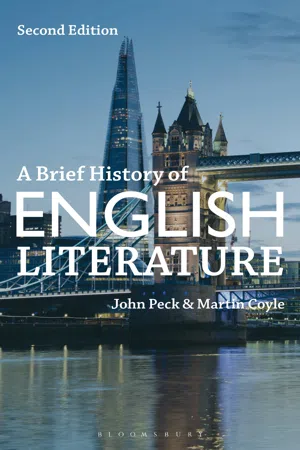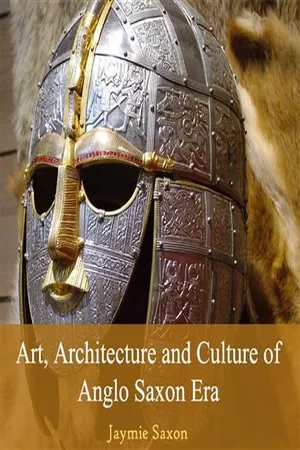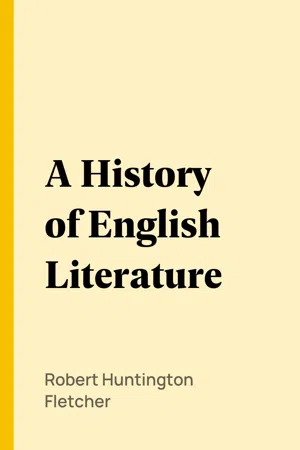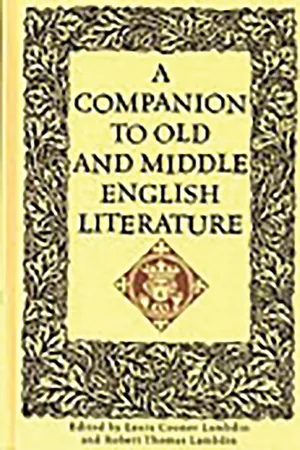Literature
Anglo Norman Literature
Anglo-Norman literature refers to the body of literature produced in England following the Norman Conquest in 1066. It encompasses a wide range of genres, including epic poetry, romances, and historical chronicles, written in the Anglo-Norman language. This literary tradition reflects the fusion of Norman and Anglo-Saxon cultural influences and played a significant role in shaping medieval English literature.
Written by Perlego with AI-assistance
Related key terms
1 of 5
6 Key excerpts on "Anglo Norman Literature"
- eBook - PDF
- John Peck, Martin Coyle(Authors)
- 2017(Publication Date)
- Bloomsbury Academic(Publisher)
As a result of the Conquest, Norman French in official and literary contexts, although, obviously, not in the day-to-day life of the majority of the population, drives out Old English. There is very little English liter-ature produced at the highest levels in the period between 1066 and 1200. What exists reflects a small and insular literary culture in retreat, helpless in the face of a continental flowering of the arts that reveals a wide variety of forms and styles. The span from 1066 to as late as 1350 is, indeed, sometimes designated as the Anglo-Norman period, because the non-Latin literature of that period was written mainly in Anglo-Norman, the French dialect of the new ruling class in England. A confident vernacular literature only really re-emerges after 1350, when English increasingly became the language spoken by those who had formerly used French. This fact was given official recognition in 1362, when English became a permitted language in law courts, and in 1385, when English became widely used in schools. But it was a form of English markedly different from Old English, with many lexical loans from French and the deletion of many Germanic words. This reordering of the language once more Middle English Literature 15 suggests how the thought processes of two cultures are likely to be found combining in the works of Chaucer and his contemporaries. A sense of activity and intermingling is very clear in the variety of Middle English literature. In broad terms, we can sum up Old English literature as belonging to a heroic age or heroic culture. ‘Heroic’ means concerned with epic battles and legendary or mythic figures; when applied to literature, it suggests a formal and dignified poetry dealing with grand concepts such as fate, honour, vengeance and social duty. - No longer available |Learn more
- (Author)
- 2014(Publication Date)
- The English Press(Publisher)
________________________ WORLD TECHNOLOGIES ________________________ Chapter-5 Anglo-Saxon Literature Old English literature (or Anglo-Saxon literature ) encompasses literature written in Old English (also called Anglo-Saxon), during the 600-year Anglo-Saxon period of England, from the mid-5th century to the Norman Conquest of 1066. These works include genres such as epic poetry, hagiography, sermons, Bible translations, legal works, chronicles, riddles, and others. In all there are about 400 surviving manuscripts from the period, a significant corpus of both popular interest and specialist research. Among the most important works of this period is the poem Beowulf , which has achieved national epic status in England. The Anglo-Saxon Chronicle otherwise proves significant to study of the era, preserving a chronology of early English history, while the poem Cædmon's Hymn from the 7th century survives as the oldest extant work of literature in English. Anglo-Saxon literature has gone through different periods of research—in the 19th and early 20th centuries the focus was on the Germanic roots of English, later the literary merits were emphasised, and today the focus is upon paleography and the physical manuscripts themselves more generally: scholars debate such issues as dating, place of origin, authorship, and the connections between Anglo-Saxon culture and the rest of Europe in the Middle Ages. Overview A large number of manuscripts remain from the 600-year Anglo-Saxon period, with most written during the last 300 years (9th–11th century), in both Latin and the vernacular. Old English literature is among the oldest vernacular languages to be written down. Old English literature began, in written form, as a practical necessity in the aftermath of the Danish invasions—-church officials were concerned that because of the drop in Latin literacy no one could read their work. - eBook - ePub
- Robert Huntington Fletcher(Author)
- 2005(Publication Date)
- Perlego(Publisher)
In language and literature the most general immediate result of the Conquest was to make of England a trilingual country, where Latin, French, and Anglo-Saxon were spoken separately side by side. With Latin, the tongue of the Church and of scholars, the Norman clergy were much more thoroughly familiar than the Saxon priests had been; and the introduction of the richer Latin culture resulted, in the latter half of the twelfth century, at the court of Henry II, in a brilliant outburst of Latin literature. In England, as well as in the rest of Western Europe, Latin long continued to be the language of religious and learned writing—down to the sixteenth century or even later. French, that dialect of it which was spoken by the Normans—Anglo-French (English-French) it has naturally come to be called—was of course introduced by the Conquest as the language of the governing and upper social class, and in it also during the next three or four centuries a considerable body of literature was produced. Anglo-Saxon, which we may now term English, remained inevitably as the language of the subject race, but their literature was at first crushed down into insignificance. Ballads celebrating the resistance of scattered Saxons to their oppressors no doubt circulated widely on the lips of the people, but English writing of the more formal sorts, almost absolutely ceased for more than a century, to make a new beginning about the year 1200. In the interval the 'Anglo-Saxon Chronicle' is the only important document, and even this, continued at the monastery of Peterboro, comes to an end in 1154, in the midst of the terrible anarchy of Stephen's reign.It must not be supposed, notwithstanding, that the Normans, however much they despised the English language and literature, made any effort to destroy it. On the other hand, gradual union of the two languages was no less inevitable than that of the races themselves. From, the very first the need of communication, with their subjects must have rendered it necessary for the Normans to acquire some knowledge of the English language; and the children of mixed parentage of course learned it from their mothers. The use of French continued in the upper strata of society, in the few children's schools that existed, and in the law courts, for something like three centuries, maintaining itself so long partly because French was then the polite language of Western Europe. But the dead pressure of English was increasingly strong, and by the end of the fourteenth century and of Chaucer's life French had chiefly given way to it even at Court. [Footnote: For details see O. F. Emerson's 'History of the English Language,' chapter 4; and T. B. Lounsbury's 'History of the English Language.'] As we have already implied, however, the English which triumphed was in fact English-French—English was enabled to triumph partly because it had now largely absorbed the French. For the first one hundred or one hundred and fifty years, it seems, the two languages remained for the most part pretty clearly distinct, but in the thirteenth and fourteenth centuries English, abandoning its first aloofness, rapidly took into itself a large part of the French (originally Latin) vocabulary; and under the influence of the French it carried much farther the process of dropping its own comparatively complicated grammatical inflections—a process which had already gained much momentum even before the Conquest. This absorption of the French was most fortunate for English. To the Anglo-Saxon vocabulary—vigorous, but harsh, limited in extent, and lacking in fine discriminations and power of abstract expression, was now added nearly the whole wealth of French, with its fullness, flexibility, and grace. As a direct consequence the resulting language, modern English, is the richest and most varied instrument of expression ever developed at any time by any race. - eBook - PDF
- Robert D. Fulk, Christopher M. Cain(Authors)
- 2008(Publication Date)
- Wiley-Blackwell(Publisher)
Introduction 2 writing, such as the products of scholasticism that arose only in the twelfth and thirteenth centuries, when silent reading became the norm in academic settings. The method of reading thus affected the very na- ture of early medieval texts (Saenger 1982: 385–6; 1997: 83–99). Even so fundamental a matter as word division is different: designed for oral delivery, Old English texts of this period organize syllables not into words but into groups arranged around a primary stress. When even so seemingly straightforward a process as reading differs in significant ways, one should expect the literature of the Anglo-Saxons to reflect some enormous material and conceptual differences in regard to matters we take for granted. One purpose of this introduction is to highlight a few of those differences, the ones most necessary to an understanding of Old English literature. For literary purposes the defining characteristic of Anglo-Saxon cul- ture is its fusion of two contrasting strains, the military culture of the Germanic peoples who invaded Britain in the fifth century and the Medi- terranean learning introduced by Christian missionaries from the end of the sixth. 2 With its emphasis on heroic legend, the native literature of the Anglo-Saxon invaders reflected the martial basis of their society. The lit- erate products of Mediterranean learning are of a sort more familiar to us: prose predominates, and genres are diverse, including sacred narra- tives, homilies, histories, annals, works of philosophy, and many other sorts, some of purely liturgical, legal, or administrative use. In the surviv- ing literature of the Anglo-Saxons these two cultural strands are woven into a single fabric, often in ways that seem startling to us. - eBook - PDF
The Arthur of the English
The Arthurian Legend in Medieval English Life and Literature
- W R J Barron(Author)
- 2020(Publication Date)
- University of Wales Press(Publisher)
3 THE ROMANCE TRADITION Catherine Batt and Rosalind Field 'Ne tut men$unge, ne tut veir' (Neither all lies, nor all true) 1 Romance, to the twentieth-century reader, may suggest fantasy, love and escapism, but the origins of medieval Arthurian romance are culturally and historically specific and we need to relocate it in its time and place in order to appreciate its cultural frame of reference (Brownlee, 1-16). In order to understand the relation between French and English romance, we need to be aware of how different are the geographical and cultural conditions of medieval northern Europe from those of the twentieth century and so rethink to some extent our categories of both nation and literature. The territories of France in the twelfth and thirteenth centuries do not correspond to its modern boundaries. The use of the French language does not define a homogeneous court culture on the Continent, and in the extraordinary conditions obtaining in post-Conquest England, several different languages -English, French, Latin, Anglo-Norman -serve the varying cultural needs of insular communities (Clanchy; Turville-Petre 1996, 181-221). That the Matter of Britain should spread from the Celtic lands of Wales and Brittany to appear in French rather than English is a consequence of the political and linguistic history of twelfth-century Britain. On the accession, in 1154, of Henry II, recently married to Eleanor of Aquitaine, the Angevin realm stretched from the Pyrenees to Scotland with Wales and Brittany in significant proximity at its borders. Moreover, there had been a sizeable Breton element in the Conqueror's original army and it was at the courts of the Norman marcher lords and amongst the Breton diaspora that the tales of the Celts would have become available to the Anglo-Normans (Bromwich, 273-98; Bullock-Davies). - Laura Lambdin, Robert Thomas Lambdin, Laura Lambdin, Robert Thomas Lambdin(Authors)
- 2002(Publication Date)
- Greenwood(Publisher)
Perhaps the best poetic example of this is Sir Gawain and the Green Knight (c. 1370), often seen as the cornerstone of AngloNorman literature. While the nobles were glorified in their share of works, this period is noted for its inclusion of the common folk who loved to hear the ballads that sang of King Horn and Robin Hood. This period also gives us a vast array of religious writings. The Ancrene Riwle (c. 1220), or the rules for an anchorite, was one of the first prose works to set definite rules demonstrating the proper ways for those determined to devote their lives to religion. The Cursor Mundi even dared to put biblical history into metrical romance, while Orm’s Ormulum paraphrased the lessons of the Gospels. Among the most prominent twelfthcentury authors were Giraldus, Wace, and Walter Map. Giraldus presented his autobiography as a means to demonstrate his dedication to his religion while attacking monastic orders. Wace is responsible for the Roman de Brut (c. 1154), one of the best histories of this time; it is also noted for its Arthurian references. Layamon based his Brut upon this work. Walter Map represents a third type of author, the courtier class. He is a curious author because he was born an aristocrat, yet he hated the court. Thus his satirical Courtier’s Trifles, composed in Latin, preaches moral lessons to those most unlikely to heed them, the nobility. Attesting to the popularity of histories during this time is the sheer bulk of volumes that are extant. Histories of England were produced by William of Malmesbury, Henry of Huntingdon, and Geoffrey of Monmouth. Geoffrey’s Page 22 History of the Kings of England (c. 1136) is perhaps the best known, although it is a prose romance rather than a true history. It, too, contains Arthurian matter, showing the popularity of this subject. The story of Abbot Samson, who is widely acknowledged as one who revolutionized monastic life, is found in Jocelin of Brakeland’s Chronicle of St.
Index pages curate the most relevant extracts from our library of academic textbooks. They’ve been created using an in-house natural language model (NLM), each adding context and meaning to key research topics.





